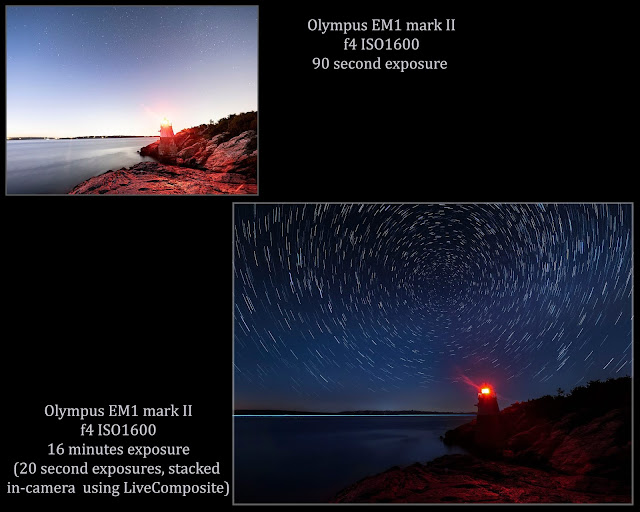I was recently asked a good question about live composite versus long exposures...
During a long exposure the exposure (all light) would build up over time, everything gets brighter, but people that have cameras with Live Composite technology can freeze the pixels and allow only new light to enter. Please note that Tom and I are Olympus Educators, but we welcome people with all camera types to come on our workshops and indeed have people with film cameras, smartphone cameras, dSLR cameras and all makes of mirrorless cameras come with us. You can view our workshops here: http://tinyurl.com/lisatomworkshops (sign up, free, to get notified of upcoming photo classes and tours)
So let's compare...
- Manual
- Bulb
- Live time
- Live composite
The image (and histogram) that would result from manual or bulb or live time would be exactly the same. The only difference is that with live time you get to SEE the exposure as it develops, see below. With live composite ambient light does not build up, only NEW light is added, see below.
Manual
-- during the exposure, everything gets brighter over the designated time
-- you cannot see the image until the 30 seconds are done
-- Bulb
-- during the exposure, everything gets brighter over the time
-- you cannot see the image until the 30 seconds are done
-- in bulb mode, you have to keep holding the shutter release but no one wants to do that because it can introduce camera shake/motion (and is not comfortable) so you hold a button on a cable release (or lock the cable release) to keep the exposure going and time it manually via another source to stop at 30 seconds (there are wireless cable releases that will show elapsed time and some cameras have built-in counter timers)
Live time
-- exposure gets brighter over the time
-- You can SEE the image and the histogram on the LCD on the back of the camera as the images develops (so you could choose to stop the exposure ay any time making your photography more productive and more FUN). Live time is great for fireworks, some lightpainting, for using ND filters, for getting long exposures making the water look smooth and clouds go long)
Live composite
-- Again you can SEE the image and the histogram on the LCD on the back of the camera as the images develops (so you could choose to stop the exposure ay any time making your photography more productive and more FUN).
-- only NEW light is added, you take a base exposure based on ambient light, and then only NEW light is added (from the earth turning and the star light or from the clouds moving or from a flashlight when lightpainting).
-- For night photography if you have ambient light (city lights, light pollution, light from a lighthouse, etc. you can control that and it will not get any brother even if you expose for an hour
--Prior to (and cameras without live composite) can accomplish this using an intervalometer to take many images and stacking all those images into layers in photoshop and masking over parts that get too bright.
-- Whether in Photoshop on in-camera using stacked images also reduces noise, as for a ten-second exposure you only have ten seconds of noise (say at 1600 iso) rather than an hour of noise if you left the camera open continuously for one hour)
--here is what the back of the camera looks like while you are exposing


